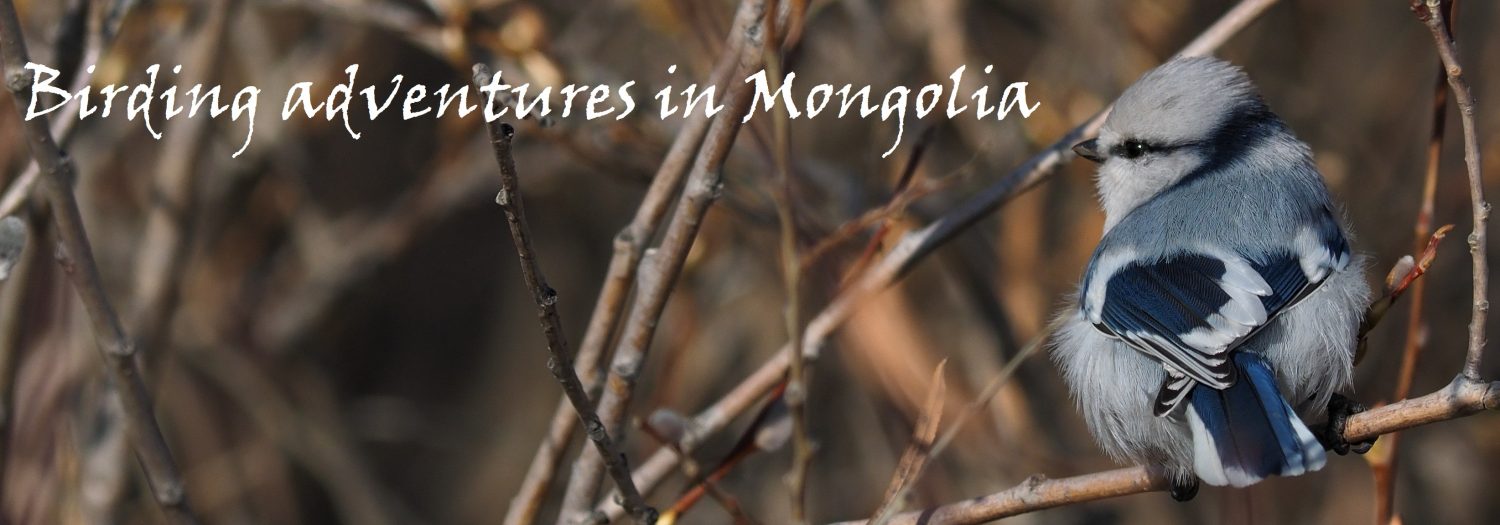
Just one hours drive northeast of Ulaanbaatar the Gorkhi-Terelj National Park takes its start. Last Saturday Abu and I went to check the area north of the Aryapala Temple. After parking close to the temple a long and steep ascend was ahead. Rocky screes, dense aspen forest and large rocks needed to be conquered in order to reach the plateau further north.
The plateau is known for its population of Black-billed Capercaillies, and Abu has seen up to 16 birds in a day there. Other classic “Taiga Forest” species also occur there including Siberian Tit, Siberian Jay, Spotted Nutcracker, Ural Owl, Three-toed Woodpecker and once Abu even found a molted primary of a Great Grey Owl there.
The ascend takes 1½ – 2 hours at medium pace. Quite early on we decided to take different routes and cover more ground.

I went straight through an area with young aspen trees. First I found a female Three-toed Woodpecker and then a Brown Accentor. It was a beautiful sunny day and as I slowly climbed higher up an adult Lammergeier flew right over my head.
As I reached the end for the forest I took a rest. Soon I heard something scratching near by. Initially I thought it was a small mammal moving through the grass and didn’t pay too much attention. The noise was moving away from me and suddenly I found out who made the noise. A Hazel Grouse was slowly walking away from me in the dense under story and was now standing fully exposed just 10 meters away. Sadly as I slowly got ready to get some photos without making sudden movements the bird took of and could not be relocated. But when the ascend alone produced such quality birds as Lammergeier, Hazel Grouse and Three-toed Woodpecker, what would the plateau give?


Lammergeier
I reached the forest on the plateau after a bit more than 1½ hours climb and entered the forest – primarily a mix of Larch and Siberian Pine. The first hour on the top of the plateau didn’t produce other birds than Siberian Nuthatches and Willow Tits. Thus I went a little bit lower and it soon paid of as I started to encounter more birds.

A family group of Siberian Jays gave amazing views for as long as I wanted. They were feeding, playing and checking me out for more than half and hour. It’s been almost 20 years since my last encounter with the species in Swedish Lappland. So I was thrilled to see them again.

As long as I stayed in the sunny part of the forest temperatures were actually quite nice. My camera didn’t freeze totally eventhough batteries died like flies. The ground was covered with snow, which was up to one feet deep at some points. But generally walking was rather easy albeit being silent was not possible.


At several points I found the Black-billed Capercaillie’s droppings, which kept hope of finding a bird alive.

Black-billed Capercaillie’s droppings
The forest had a true Siberian flavor to it as several Spotted Nutcrackers and no less than 11 Siberian Tits were observed.


Siberian Tit
A Black Vultures also took an interest in me at one point as it circled the tree tops for a few minutes.

There was very limited phone coverage on the plateau, but I received a text from Abu, who had just seen a White-backed Woodpecker. But then his phone died and we only saw each others tracks every now and then.
After walking for about seven hours I started descending and shortly after Abu appeared further away. About half way down our paths crossed and we got to share our sightings. And (of coruse) Abu had seen a female Black-billed Capercaillie just sitting put in a tree until he left. Apart from the chicken he had also seen a Grey-headed Woodpecker, Siberian Tits and a single Siberian Jay.

All in all I was really satisfied with the birds even though the Black-billed Capercaillie escaped for now. The whole experience of breath-taking scenery, hard-core rock-climbing, Siberian Jays, Hazel Grouses, Siberian Tits, Lammergeiers and Abu’s company are more than enough to make it an awesome day out.

And for the first time I really got to appreciate my new Olympus 300 f4 lens, that performed really well in spite of its small size. It has the same magnification as my 300 f2.8, but is much smaller and lighter. With a 1,4 teleconverter I get the equivalent of a 840 mm Full Frame camera weighing only about 2,3kg incl. camera, battery and teleconverter. Even with my old 5.8 kg Olympus 300 f2.8 the 1½ climb would have been quite a challenge. And I am glad I don’t need to carry full-frame glass all the way up there. Now if only I could afford the new Olympus EM1X …
Silas

Gorgeous photos! (And thanks for the lens comparison, too!)
LikeLike